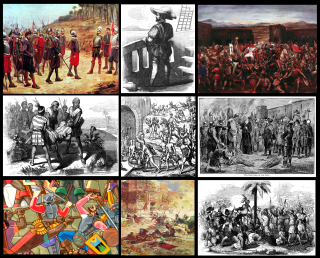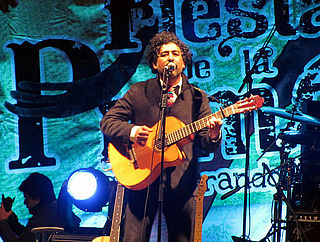
Francisco Pizarro González was a Spanish conquistador, best known for his expeditions that led to the Spanish conquest of Peru.

Atahualpa, Atawallpa (Quechua), also Atabalica, Atahuallpa, Atabalipa was the last Inca Emperor. After defeating his brother, Atahualpa became very briefly the last Sapa Inca of the Inca Empire (Tawantinsuyu) before the Spanish conquest ended his reign.

Atahualpa Yupanqui was an Argentine singer, songwriter, guitarist, and writer. He is considered the most important Argentine folk musician of the 20th century.

The Spanish conquest of the Inca Empire, also known as the Conquest of Peru, was one of the most important campaigns in the Spanish colonization of the Americas. After years of preliminary exploration and military skirmishes, 168 Spanish soldiers under conquistador Francisco Pizarro, his brothers, and their indigenous allies captured the Sapa Inca Atahualpa in the 1532 Battle of Cajamarca. It was the first step in a long campaign that took decades of fighting but ended in Spanish victory in 1572 and colonization of the region as the Viceroyalty of Peru. The conquest of the Inca Empire, led to spin-off campaigns into present-day Chile and Colombia, as well as expeditions towards the Amazon Basin.
"Los Hermanos" is a poetic folk song composed and first performed by Argentine nueva canción singer Atahualpa Yupanqui.

The Comentarios Reales de los Incas is a book written by Inca Garcilaso de la Vega, the first published mestizo writer of colonial Andean South America. The Comentarios Reales de los Incas is considered by most to be the unquestioned masterpiece of Inca Garcilaso de la Vega, born of the first generation after the Spanish conquest.

César Isella was an Argentinian singer and songwriter of folk music. He joined Los Fronterizos from 1956 to 1966, was one of the main figures of the "Movement of the New Songbook", and in the 1990s he discovered and sponsored the singer Soledad Pastorutti. He has written the music for "Canción con todos", regarded as the Latin American anthem.

Manuel Javier García Herrera is a folk-pop Chilean singer-songwriter and guitarist. He has won several awards and has twice received the Chilean National Music Prize, awarded by the Chilean Government.

Abel Pintos, is an Argentinian singer-songwriter. He started his solo career at the age of 13 with his album Para cantar he nacido, supported financially by León Gieco. After the release of four studio albums, he started writing his own songs that marked a departure from his folk style.

Antonietta Paule Pepin Fitzpatrick, also known as Nenette, was a French composer, pianist and lyricist, wife of the Argentine singer Atahualpa Yupanqui.

Palmenia del Carmen Pizarro González, better known as Palmenia Pizarro, is a Chilean singer.

Una Voz y una Guitarra is an album by Argentine singer and guitarist Atahualpa Yupanqui. It was released in October 1953 on the Odeon label. It was Yupanqui's first album. It was the No. 1 album in Argentina in its year of release.

Solo de Guitarra, Volumen No. 6 is an album by Argentine singer and guitarist Atahualpa Yupanqui. It was released in 1958 on the Odeon label. It was the No. 1 album in Argentina in 1958.

Selva, Pama y Cerro is an album by Argentine singer and guitarist Atahualpa Yupanqui. It was released in 1964 on the Odeon label. It was the No. 1 album in Argentina in 1964.

Solo de Guitarra, Volumen No. 3 is an album by Argentine singer and guitarist Atahualpa Yupanqui. It was released in 1956 on the Odeon label.

Canto y Guitarra, Volumen No. 5 is an album by Argentine singer and guitarist Atahualpa Yupanqui. It was released in 1958 on the Odeon label.

¡Soy Libre! ¡Soy Bueno! is an album by Argentine singer and guitarist Atahualpa Yupanqui. It was released in 1968 on the Le Chant du Monde label.

Canción para Pablo Neruda is an album by Argentine singer and guitarist Atahualpa Yupanqui. It was released in 1975 on the Le Chant du Monde label.

Arenita del Camino, Volumen No. 9 is an album by Argentine singer and guitarist Atahualpa Yupanqui. It was released in 1961 on the Odeon label.
Yolanda Pérez de Carenzo, known as "La Niña Yolanda", was an Argentinian pianist.

















